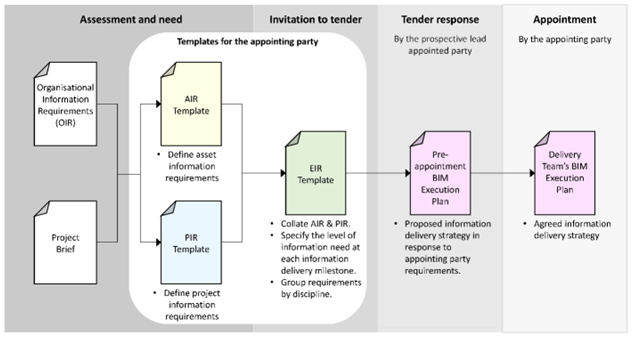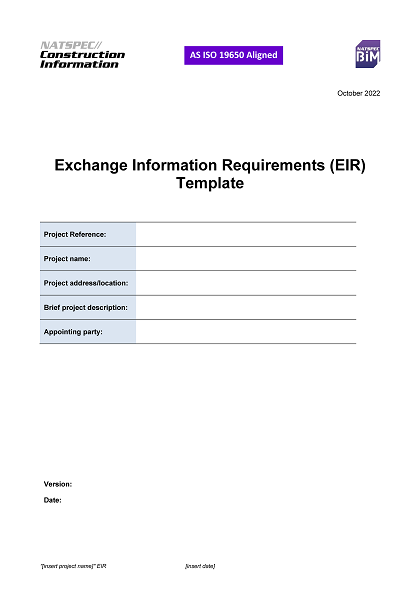Terminology
AS ISO 19650 terminology has been adopted. For an explanation of terms such as appointing party, lead appointed party and exchange information requirements (EIR), see the NATSPEC National BIM Guide including Appendix A – Glossary.
The requirement for a BIM execution plan
A BIM execution plan (BEP) is a formal document that defines how a project will be executed, monitored and controlled with regard to BIM. One of its main purposes is to make clear what members of the project team can expect from each other – who is meant to do what, and how, and when.
Template purpose
The NATSPEC National BIM Guide BEP templates provide a framework for planning the development and delivery of information in response to the appointing party’s information requirements for a project. They include items that need to be considered as part of this process, and guidance and references to information that supports decision making.
The templates also foster a consistent approach across industry, organisations and projects. On projects this helps get everyone on the same page from the beginning and be productive from day one. Templates are provided for two types of BEP:
- Pre-appointment BEP - Combined: AS ISO 19650.2 clause 5.3.2 requires the prospective lead appointed party to establish the delivery team’s pre-appointment BEP, to be included in their tender response.
- Delivery Team BEP - Combined: Following their appointment, AS ISO 19650.2 clause 5.4.1 requires the lead appointed party to confirm the delivery team’s BEP in agreement with each appointed party.
‘Combined’ means the templates include clauses relevant to the design and construction phases of a project so they can be used to create a Design BEP, Construction BEP or a combined Design and Construction BEP.
Both templates follow a similar format and include some duplication of content.
Audience
The templates are primarily for appointed parties who do not already have well-developed BEPs or BEPs aligned to AS ISO 19650 principles. Appointed parties with limited experience of planning information delivery in conformance with AS ISO 19650 principles should consider professional assistance with this task.
The BEP templates can also be used by appointing parties to create templates that reflect their general organisational requirements and/or preferred approach to BIM implementation. An organisational BEP can then be customised to reflect the specific requirements of individual projects. This is particularly worthwhile for agencies or organisations with portfolios of projects.
Template features and structure
The Templates are editable Word files that can be customised to create a BEP to suit a specific project and respond to the appointing party’s EIR or Project BIM Brief (See description at end of article). Both include guidance to assist with their completion.
The templates embody AS ISO 19650 concepts and principles and are structured around processes described in the standard. Template sections are based on the three aspects of producing information identified in AS ISO 19650.1, Section 5:
- Commercial: Aspects of information delivery relevant to appointment or contract conditions, e.g. delivery team members, information purposes, information deliverables.
- Management: Management processes to be adopted for the implementation of BIM, e.g. information quality assurance, information security and privacy and CDE management. In describing these requirements, reference may be made to standards and procedures described in more detail in the Technical section.
- Technical: Technical requirements or provisions that support the delivery and management of information, e.g. details of information technology, project infrastructure requirements and technical standards applicable to the project.
Using the templates
Templates are not an end in themselves, but aids that support project management tasks by providing a framework for capturing key decisions and information.
To accommodate a wide range of users, the templates assume a ‘blank sheet’ starting point and embody a first-principles approach to developing a BEP.
There are now numerous examples of BEPs and BEP templates available that can be useful sources of information, but it should be kept in mind that they often represent the requirements of a specific agency or organisation. While using them is appropriate when working on their projects, it can be problematic using them on other projects. Developing a BEP using the NATSPEC templates prompts consideration of key aspects of project information delivery using BIM and provides contextual guidance to assist decision making on them.
NATSPEC Pre-appointment BEP templates [829 KB] Download
NATSPEC Delivery team BEP templates [936 KB] Download
Project BIM Brief
The downloadable zipped folder includes a Project BIM Brief template, a high-level document that can be used early in a project when BIM is first considered, primarily for recording the client’s requirements regarding the application of BIM. It is directed at the client and members of the project team with intermediate BIM skills, i.e. principals of each major consultant and project team leaders, ideally with the support of a Lead BIM Adviser or Lead Consultant with BIM expertise.

Templates
 Editable templates include
Editable templates include
- AIR template (AS ISO 19650 aligned).
- PIR template (AS ISO 19650 aligned).
- EIR template (AS ISO 19650 aligned).
- Project BIM Brief (PBB) Template. This serves a similar function to the PIR and EIR templates. Useful for simpler projects and eliciting a BIM brief from clients.
All Templates [440 KB] Download

